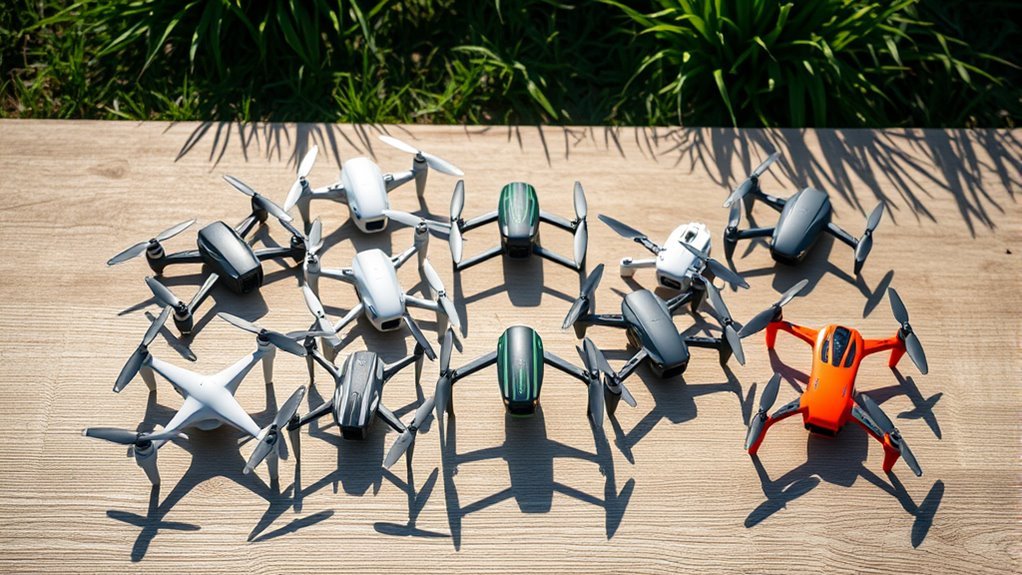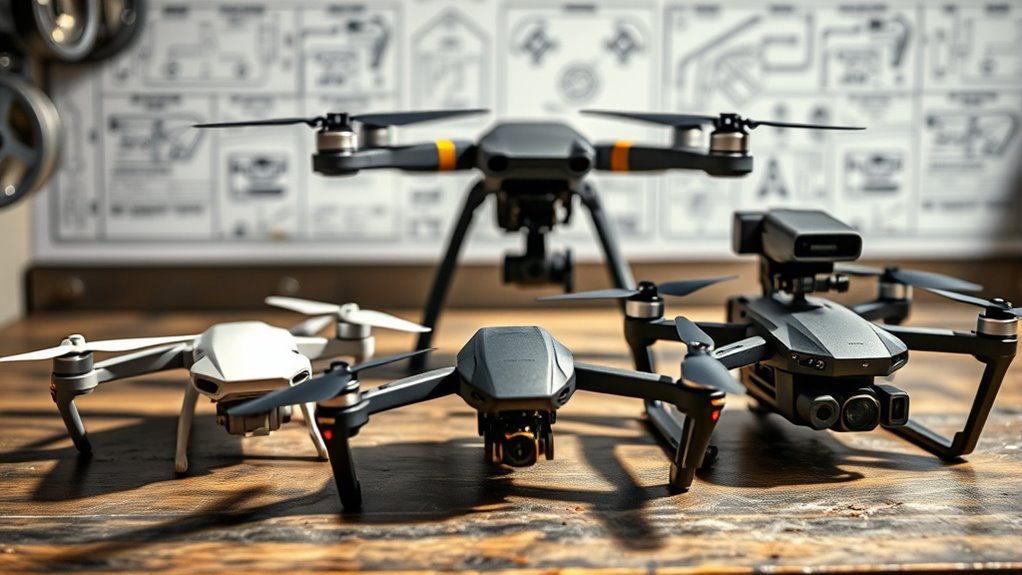You need to register drones that weigh over 0.55 pounds or are used for commercial purposes, including those equipped with cameras or sensors. Registration is also mandatory for specialized drones, such as those in agriculture, delivery services, racing events, and government operations. This guarantees compliance with safety, privacy, and regulatory standards. Understanding these categories will help you navigate drone regulations effectively and guarantee responsible operation within legal frameworks.
Recreational Drones Over 0.55 Pounds

Although recreational drones are commonly used for personal enjoyment and hobbyist activities, any model weighing more than 0.55 pounds (250 grams) must be registered with the appropriate aviation authority before operation. You must understand that complying with drone safety protocols and flying regulations is essential to guarantee both your freedom to fly and the safety of others. Registration helps authorities track your drone in case of incidents or violations, promoting responsible usage. Failure to register can result in penalties and restrict your ability to operate freely in controlled airspace. By adhering to these requirements, you demonstrate respect for public safety and contribute to the sustainable growth of recreational drone use, allowing you to enjoy flight privileges within the legal framework designed to protect all airspace users.
Commercial Drones Used for Business Purposes

While recreational drones over 0.55 pounds require registration, commercial drones used for business purposes are subject to more stringent regulatory requirements. When you operate drones for business applications, you must comply with specific industry regulations to guarantee safety and legal use. Registration is mandatory, and additional certifications may be required depending on your operational scope.
| Business Application | Regulatory Requirement |
|---|---|
| Agriculture | FAA Part 107 Certification |
| Infrastructure Inspection | Operational Authorization |
| Delivery Services | Airspace Authorization |
Understanding these distinctions allows you to maintain freedom in your commercial drone operations while adhering to regulatory standards, safeguarding both your business interests and public safety.
Drones Equipped With Cameras or Sensors

If your drone is equipped with cameras or sensors, you’ll need to take into account specific privacy regulations that govern their use. Understanding the capabilities of these sensors is essential, as they can range from simple imaging to advanced data collection. Additionally, drones with such equipment often require mandatory registration to guarantee compliance with legal standards.
Privacy Regulations Impact
Because drones equipped with cameras or sensors can capture detailed visual and environmental data, they are subject to stringent privacy regulations designed to protect individuals’ personal information. You must understand that privacy concerns arise from unauthorized data collection, potentially infringing on personal spaces. To operate such drones lawfully, you need to guarantee full regulatory compliance, which often includes registering the drone, adhering to data protection laws, and obtaining necessary permissions. These measures balance your freedom to use advanced drone technology with the imperative to respect privacy rights. Failure to comply can result in legal penalties and restrictions, limiting your operational scope. By aligning with privacy regulations, you can responsibly leverage your drone’s capabilities while safeguarding individual privacy and maintaining public trust.
Sensor Capabilities Overview
Understanding the privacy regulations surrounding drones with cameras or sensors naturally leads to examining the specific sensor capabilities these drones possess. You’ll find that various sensor types—such as optical cameras, infrared sensors, LiDAR, and multispectral sensors—offer distinct detection capabilities. Optical cameras capture visual data, while infrared sensors detect heat signatures, enabling operation in low visibility. LiDAR provides precise distance measurements through laser pulses, enhancing spatial awareness. Multispectral sensors gather data across multiple wavelengths, useful for specialized analysis. These detection capabilities directly influence how drones collect and process information, impacting privacy considerations. By grasping the technical specifications of sensor types, you maintain awareness of the drone’s functional potential while preserving your autonomy within regulated airspace.
Camera Drone Registration
Although many drones offer impressive sensor arrays, those equipped with cameras or other data-collecting sensors must be registered with the appropriate aviation authorities before operation. Compliance with camera drone regulations guarantees lawful use and supports camera drone safety by mitigating risks associated with privacy and airspace intrusion. When registering your camera drone, consider these factors:
- Registration requirements vary depending on the drone’s weight and intended use, so verify the specific criteria in your jurisdiction.
- Provide detailed information about the drone’s camera capabilities, as certain sensors may impose additional restrictions.
- Maintain your registration credentials and adhere strictly to operational guidelines to preserve your freedom while guaranteeing safety.
Proper registration balances technological freedom with responsible use, essential for sustaining camera drone operations.
Drones Exceeding Specific Weight Limits
When your drone surpasses certain weight thresholds set by aviation authorities, it must be registered before operation. Typically, drones exceeding 0.55 pounds (250 grams) fall under mandatory registration requirements. This drone weight criterion guarantees operators maintain accountability and comply with safety standards. The registration process involves providing identification details, specifying the drone’s characteristics, and obtaining a unique registration number that must be displayed on the device. Adhering to these regulations is essential to preserve your freedom to fly while minimizing risks to public safety and airspace integrity. Failure to register a drone exceeding prescribed weight limits can lead to penalties, restrictions, or confiscation. Understanding and completing the registration process promptly empowers you to operate your drone responsibly within legal frameworks.
Racing Drones Participating in Organized Events
Since racing drones are often flown in competitive, organized events, they are subject to specific registration requirements distinct from recreational drones. If you participate in such events, you need to guarantee your racing drone complies with regulations due to its enhanced capabilities and modifications. These drones often undergo extensive drone modifications to maximize speed and agility, which can affect safety and control.
Racing drones require specific registration and compliance due to their enhanced speed, agility, and modifications.
Key considerations include:
- Registering the drone with the appropriate aviation authority before competing.
- Confirming the drone meets weight and performance criteria established for competitive events.
- Maintaining documentation of any modifications to verify compliance and facilitate inspections.
Agricultural Drones for Crop Monitoring and Spraying
Beyond the competitive domain of racing drones, agricultural drones play a significant role in modern farming practices. You’ll find these drones indispensable for monitoring crop health through multispectral imaging, enabling precise detection of stress, disease, or nutrient deficiencies. By integrating GPS and advanced sensors, agricultural drones support precision agriculture, allowing you to apply fertilizers or pesticides accurately and efficiently. This targeted approach reduces chemical usage and environmental impact while maximizing yield. Since these drones operate over expansive farmland and carry payloads like spraying systems, regulations require their registration to guarantee safe and responsible use. Registering your agricultural drone grants you the freedom to leverage cutting-edge technology for sustainable farming while complying with legal standards designed to protect airspace and public safety.
Delivery Drones Operating in Urban Areas
Numerous delivery drones operating in urban areas are transforming last-mile logistics by enabling rapid, contactless parcel transport. When you deploy these drones, you must navigate complex regulatory challenges inherent to urban logistics, ensuring compliance without compromising operational freedom. To effectively incorporate delivery drones, consider these key aspects:
- Flight Path Management: Precise geofencing and obstacle avoidance systems are critical to maintain safety and efficiency within dense urban environments.
- Privacy and Noise Regulations: Adhering to local ordinances protects citizens’ rights and minimizes disturbances, balancing innovation with community standards.
- Registration and Identification: Maintaining accurate registration facilitates accountability and integrates drones into national airspace systems.
Government and Public Safety Drones
When you operate government or public safety drones, you must consider their critical roles in emergency response and law enforcement surveillance. These drones often require registration due to their specialized functions and regulatory oversight. Understanding their operational scope helps guarantee compliance with legal and safety standards.
Emergency Response Applications
Although primarily operated by government agencies, drones used in emergency response applications play an essential role in public safety by providing rapid aerial assessment, search and rescue support, and real-time situational awareness. When you utilize emergency drone technology, it enhances disaster response strategies by enabling quicker, safer decisions in challenging environments. Key advantages include:
- Rapid Damage Assessment – You can quickly evaluate disaster zones, identifying hazards and prioritizing resources efficiently.
- Search and Rescue Operations – Drones equipped with thermal imaging help locate missing persons in difficult terrain.
- Communication Relay – During infrastructure failures, drones act as temporary communication nodes to maintain coordination.
Understanding these functions allows you to appreciate why such drones must be registered, ensuring accountability and integration into official emergency frameworks.
Law Enforcement Surveillance
Since law enforcement agencies rely on drones for surveillance to enhance public safety, these devices must comply with strict registration requirements. When you operate drones for lawful surveillance, you’re bound by regulations ensuring drone accountability to protect citizens’ rights. Registration creates a transparent framework, enabling oversight and preventing misuse. This accountability balances public safety needs with individual freedoms, ensuring surveillance is conducted within legal parameters. By registering your drone, you acknowledge the responsibility to use it ethically and within the scope of authorized operations. Failure to comply undermines trust and may lead to legal consequences. As a result, adherence to registration protocols is essential for maintaining lawful surveillance practices that respect privacy while empowering you to support community security effectively.

